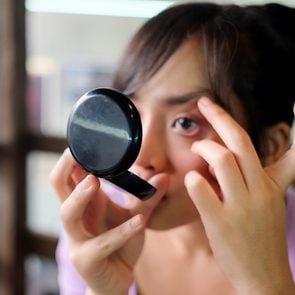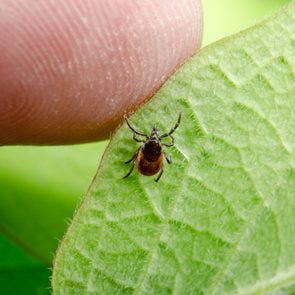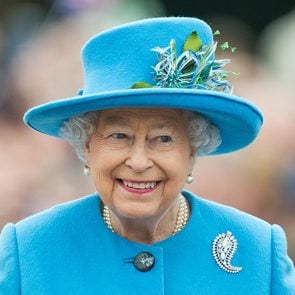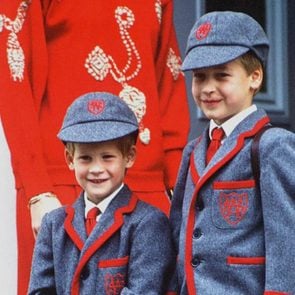When Katie Clow arrives in her windowless lab at the Ontario Veterinary College, in Guelph, she often finds a pile of envelopes. Each one contains a slip of paper and a small plastic vial or two. The paperwork lists the name of a veterinary clinic somewhere in Canada and the identifying details of someone’s pet: a six-year-old golden retriever in Moncton, a four-year-old tabby in Victoria.
Inside each corresponding vial is a tick—or several—plucked from the body of that pet and mailed in for research. Clow, a 34-year-old assistant professor of veterinary medicine with expertise in epidemiology and ecology, opens the vials and tips the rigid bodies of the arachnids into a petri dish. The ticks are stored in the fridge until Clow, whose students call her the Tick Queen, has time to sit down with a box of them. She can identify the ticks quickly, by species and by gender, based partly on the appearance of their hard outer shell, called a scutum, and sometimes by the shape of their protruding mouthparts.
Once identified, the ticks go under the knife. Ticks that were found and removed before they had time for a long feed are smaller than a watermelon seed and nearly as crunchy; they resist the scalpel. But the engorged ticks, the ones that had a hearty blood meal, can be swollen up like stewed cranberries. Cutting them is more like carving a soggy M&M. Clow and her team marinate the chopped ticks in chemical reagents, then run them through a process that extracts the DNA in the bug hash.
There are two main types of genetic material they are looking for in blacklegged ticks, known by the scientific name Ixodes scapularis, including Borrelia burgdorferi, the bacteria that causes Lyme disease, which causes fever, fatigue and joint aches and is a growing public health problem. There were a preliminary 2,636 cases reported to the Public Health Agency of Canada in 2019, the last year for which data is available, and the agency speculates that cases are underreported, predicting as many as 10,000 new cases each year in the 2020s.
Lyme rates are surging because the ticks that spread it—I. scapularis, predominantly—are rapidly expanding their range. I. scapularis is no bigger than a poppy seed when it does most of its damage, but this particular tick is emerging as an outsized threat. “The sky seems to be the limit for them,” says Robbin Lindsay, a research scientist at the National Microbiology Laboratory in Winnipeg. “They are taking over the reins as the number one vector of pathogens to humans.”
Climate change has made much of the most populated part of Canada an ideal habitat for many species of ticks. In the early 1970s, there was just one known colony of blacklegged ticks in Canada, at Long Point, on the north shore of Lake Erie. By the 2000s, the tick was being found all over southern Ontario, Quebec, Manitoba and the Atlantic provinces. Today they’re marching steadily west from Manitoba on their eight tiny legs.
On a cold grey autumn afternoon in 2019, Katie Clow takes me into the woods, an hour’s drive from Guelph, to drag for ticks. She equips me with a white hazmat suit, seals off my ankles with duct tape and hands me a white flannel blanket taped to a metre-long stick. Then we set off into the underbrush, dragging the blanket awkwardly over brambles. After about an hour in the forest with Clow, I stop and, right near the top, heading with surprising speed for the handle I see—something? “Katie,” I ask, “is this a tick?”
Clow hurries to me, leans in for a look and lights up like it’s Christmas morning. I have picked up an adult female blacklegged tick. A short while later, Clow finds a tick on her own blanket and is equally pleased: you’d never guess that she has encountered 10,000 ticks in her professional life. She identifies it—another I. scapularis—then gently sets it down on a leaf so I can have a good look. The tick immediately scooches to the end of the leaf and begins to wave its front legs back and forth.

“Ooh,” Clow croons. “She’s questing!”
A questing tick waits at the end of a blade of grass or leaf, with its legs outstretched, tracking the changes in heat and CO2 that signal something biteable is walking by, poised to jump aboard. A tick can live for a couple years without feeding. But, like video game vampires, they need blood to level up and move between stages of the life cycle. They start out as eggs, which hatch into larvae. When the larvae have fed on something small, they drop back to the ground and moult, becoming nymphs. As nymphs, they develop that last set of legs and can, at this stage, host many pathogens. When the next blood meal happens, typically off a larger creature, they are able to be infected with bacteria or viruses—and to pass them on.
It’s a risky requirement, this need to feed on an exponentially larger and faster-moving host, when you’re a tiny, slow-moving creature. But ticks have found a range of ways to navigate that risk. A tick can coat its body in its own saliva, a liquid salty enough to pull moisture from the atmosphere. That is sustenance enough to go for those months—or years—while it’s waiting for a meal.
When it does attach, the saliva also helps it stay on your body. Among the 3,500 proteins identified in the saliva of various ticks, some stop the molecules from carrying a pain signal, while others are vasodilators, to get the blood flowing, or anticoagulants, to keep it from clotting. Some proteins stop the histamine response, which would make the bite itch and clear a path for immune cells to reach the site. And, because the tick needs to keep feeding for days— keeping your immune system inhibited—it changes up the protein composition of its saliva, like a dash into a phone booth for a new disguise.
Ticks like their tissue soft and thin, as Eric Stotts can tell you. In October 2019, Stotts went on a guys’ weekend to a cabin near Port Mouton, on Nova Scotia’s south shore, a couple of hours from his home, in Halifax. A 49-year-old architect, Stotts goes with his buddies every year, and they always take on a project and learn a new skill. Last fall it was filmmaking, and Stotts spent much of the weekend crouching and lying on the forest floor as he filmed. He thought his film turned out pretty well, and when he was back in his home office on Monday, he was feeling good about things.
Until he went to pee.

And there, on the end of his penis, was something small and black. He headed to the medicine cabinet for tweezers. He knew the procedure: he had to make sure he got the whole tick out, including the head and mouthparts. Using Google, Stotts quickly confirmed that his new companion was I. scapularis. He kept the tick and headed to a walk-in clinic, wondering if the tick should be tested for Lyme disease. When he told the nurse what had happened, the response was not what he expected.
“Well, that’s the second one I’ve had this week,” the nurse told him.
The doctor Stotts saw did not send the tick for testing: at this point, the protocol in Nova Scotia is to prophylactically treat anyone likely to have been exposed to Lyme disease. Stotts swallowed “horse pill” antibiotics for two weeks and sent an email to all the guys who had been with him that weekend, warning them to do a tick check. (They were all tick-free.)
Even a decade ago, when Stotts started going on those weekends away, there were only a handful of tick populations in Nova Scotia; now, the region south of Halifax is the second-biggest source of mail-ins for Clow’s pet-tick study. There is a lot of debate among scientists about why the tick habitat keeps expanding, but climate change figures in almost every hypothesis.
Of all the environmental factors that affect the size of tick populations, temperature is the most important. Shorter, warmer winters are good for ticks’ life cycles. It’s not that they freeze in winter (so long as they’re hunkered down in the leaf litter). Rather, when it’s colder, a tick takes longer to quest and is slower to move through each stage of the life cycle—so a greater proportion of them die before the cycle is completed. At the same time, milder winters mean that migratory birds are nesting progressively further north, transporting ticks with them.
Back in the 1980s, when Lyme disease was emerging as a serious public health problem in the U.S., some data suggested that most of Canada was too cold to have to worry about the blacklegged tick; research confirmed this again in the early 2000s. But that’s no longer the case. “Every year, we see this creep northward,” Clow says, “where sites that didn’t have ticks the year before are now positive.”
On a September day in 1958, four-year-old Lincoln Byers was in the barn on his family’s farm, 12 kilometres west of Powassan, Ontario, when his brothers noticed he seemed ill. He was soon rushed to the Hospital for Sick Children in Toronto. When he got there, Lincoln was feverish but with no obvious cause of illness. Two days later, he was fading in and out. On the fourth afternoon, he stopped breathing and was placed on a respirator. He died two days later.

His devastated parents gave permission for an autopsy. Donald McLean, a virologist at the hospital, cultured fragments of Lincoln’s brain and injected the product into mice, which developed signs of acute encephalitis—except the mice didn’t test positive for any known strain of the disease. McLean realized it must be a new virus, and the closest comparison he could find was an infection that was transmitted by ticks in Russia. So McLean picked up a gun and drove to the Byers’ farm. They killed squirrels, chipmunks, rabbits and other mammals and harvested any ticks they found. Sure enough, some of the animals also had the mystery virus.
Eventually McLean concluded that Lincoln had likely been bitten by an infected tick while holding dead squirrels his brothers were skinning. Newspapers later ran alarmed stories, but Lincoln’s death remained a tragic exception. By 2009, fewer than 50 cases of what came to be called Powassan virus had been reported anywhere. That, Clow says, makes for an interesting epidemiological mystery: the virus is clearly circulating somewhere in the wild, being passed from ticks to mammals and back again, often enough that there are these rare infections. It isn’t just I. scapularis that’s spreading, either. In August 2017, a woman in New Jersey was shearing her pet sheep when she discovered ticks. And not just a few: by the time she made it to her local public health department, she had more than 1,000 ticks on her arms and clothing. There, entomologists struggled to identify the ticks—they didn’t look like anything local—and eventually Rutgers University scientists had to use DNA to establish that they were
Haemaphysalis longicornis, the Asian longhorned tick. It is native to Japan, Korea, China and far-eastern Russia.
In Asia, it is a source of serious illness, including a hemorrhagic fever called Huaiyangshan banyangvirus, which is fatal for up to 30 per cent of those who catch it. H. longicornis was the first invasive tick species found in the United States in 80 years. Clow and Lindsay say it’s only a matter of time until it is discovered in Canada.
In 2004, I was living in South Africa and travelling for work across the continent. One day I developed a terrible fever; a crusty black scab, about five centimetres in diameter, on the back of my left calf; and lymph nodes as hard as stone. A succession of doctors diagnosed me with everything from a spider bite to cutaneous anthrax before an acerbic elderly South African medic surveyed me in a hospital bed and said, “Rickettsia africae. Good old tick-bite fever.”
I recovered from Rickettsia africae after 48 hours on antibiotics. It remains, though, the sickest I’ve ever been. I never again went into long grass or paddocks in tropical countries without dousing my legs with DEET. Yet I didn’t take the same steps when I was back in Canada—not until Katie Clow took me tick dragging. She thinks about the campaigns that have, in her lifetime, persuaded people to use seat belts, quit smoking and wear sunscreen, and she wonders how long it will take for the change to come with ticks.
Since my day in the woods with Clow, the Canadian forest trails I have walked since I was a child feel different. In the woods these days, I get the occasional cold prickle on the back of my neck. It’s not the sense that bears or wolves might be watching me. It’s not the fear of getting lost in the cold. It is the knowledge that there are thousands upon thousands of tiny hunters who can sense my breath and who are waiting, poised at the end of a long blade of grass, their front legs outstretched, for me to come close.
Next, read up on five tick-borne diseases found in Canada.
© 2020, Stephanie Nolen. From “Invasion of the Ticks,” The Walrus (July 21, 2020), thewalrus.ca
Although Queen Elizabeth II lost her beloved husband Prince Philip in April, 2021 has also seen some happy new arrivals to Her Majesty’s family, including three great-grandchildren. The newest addition was announced on June 4: a baby girl, Lilibet Diana, born to Prince Harry and Meghan, the Duke and Duchess of Sussex.
While a few of the Queen’s great-grandchildren have royal titles and are in the top five spots in the line of succession, most are expected to lead regular lives and pursue their own careers when they grow up. Regardless of whether the baby is third or twenty-third in line to the throne, the birth of a new grandchild for the Queen always attracts public attention.
Here are the Queen’s great-grandchildren in age order, from oldest to youngest:
Savannah Anne Kathleen Phillips, born December 29, 2010
18th in line to the throne
View this post on Instagram
Savannah (at rear, above) is the elder daughter of the Queen’s oldest grandchild Peter Phillips (the son of Princess Anne) and Autumn Kelly. Her name was revealed to the public before the official announcement when a church service on the royal estate of Sandringham included a prayer for “Peter and Autumn Phillips and their daughter Savannah.” While Savannah is a new name for a member of the Queen’s family, her middle names Anne and Kathleen honour her grandmothers, Princess Anne (the Princess Royal) and Kathleen Kelly. Savannah was a bridesmaid at the wedding of her father’s cousin Princess Eugenie in 2018 and has appeared on the balcony at Trooping the Colour, the Queen’s official birthday celebrations in the United Kingdom. Savannah’s parents, Peter and Autumn, separated in 2019.
Isla Elizabeth Phillips, born March 29, 2012
19th in line to the throne
Isla (third from right, above) is the younger daughter of Peter Phillips and Autumn Kelly. Born the same year as Queen Elizabeth II’s Diamond Jubilee, her middle name honours her great-grandmother. Like her older sister Savannah, she was a bridesmaid at Princess Eugenie’s wedding and has appeared on the balcony at Trooping the Colour. Both Isla and Savannah have dual British and Canadian citizenship because their mother was born in Montreal.
These royal family “rules” are complete myths.
His Royal Highness Prince George Alexander Louis of Cambridge, born July 22, 2013
3rd in line to the throne
View this post on Instagram
The eldest child of Prince William and Catherine, the Duke and Duchess of Cambridge, George is expected to become King after the eventual reigns of his grandfather, Prince Charles, and father, Prince William. George was the name of six previous kings including Queen Elizabeth’s father, King George VI.
Once Catherine’s pregnancy was announced in December 2012, there was a media frenzy, and journalists and photographers spent weeks outside the Lindo Wing of St. Mary’s Hospital in London during what became known as “The Great Kate Wait” in July 2013. When George finally arrived, the news was posted on an easel outside Buckingham Palace in addition to a press release and social media posts. The bells rang at Westminster Abbey, there were 21-gun salutes across the United Kingdom and Commonwealth, and Canadian landmarks including the CN Tower and Niagara Falls were lit up in blue. Commemorative coins were released with the newborn prince’s image in the United Kingdom, Canada and Australia.
William and Catherine are protective of their children’s privacy but George has made public appearances on family occasions and joined his parents at several public engagements. He was a page boy at the 2018 weddings of Prince Harry and Meghan Markle and Princess Eugenie and Jack Brooksbank. George has accompanied his parents on Commonwealth tours in the past, visiting Australia and New Zealand in 2014, and Canada in 2016 where he attended a party for military families. Perhaps his most famous public appearance took place on April 22, 2016, when he met American President Barack Obama at Kensington Palace dressed in a miniature monogrammed bathrobe. George has a close relationship with his great-grandmother the Queen, who he calls “Gangan.”
Here are 15 details you probably missed from Prince William and Kate’s wedding.
Mia Grace Tindall, born January 17, 2014
21st in line to the throne
View this post on Instagram
Mia is the eldest of the three children of Zara Phillips (the daughter of Princess Anne and a member of the silver medal winning British equestrian team at the 2012 Summer Olympic Games in London) and Mike Tindall (a professional rugby player and sports podcaster). While Mia is not a name that has previously appeared in the royal family, King George III’s youngest and favourite daughter was named Amelia. Mia attracted worldwide attention when she was pictured holding the Queen’s handbag alongside her cousins and second cousins in photo taken by Annie Leibowitz in honour of the Queen’s 90th birthday. Mia’s mother, Zara, is one of Prince George’s godparents and George and Mia have had playdates together.
Don’t miss these rarely seen photos of the British royal family through the years.
Her Royal Highness Princess Charlotte Elizabeth Diana of Cambridge, born May 2, 2015
4th in line to the throne
View this post on Instagram
The second child of Prince William and Catherine, the Duke and Duchess of Cambridge, Princess Charlotte was born the same year that succession reform came into force in the United Kingdom and Commonwealth. While past generations of princesses ranked behind any younger brothers in the line of succession, the reforms made the succession gender neutral and Charlotte remained 4th in line to the throne after the birth of her younger brother, Prince Louis.
Charlotte’s first name honours her paternal grandfather Prince Charles and maternal grandmother Carole Middleton, her middle names honour her great-grandmother Queen Elizabeth and her late paternal grandmother, Diana, Princess of Wales. Like her brother George, Charlotte has accompanied her parents on overseas tours, visiting Canada in 2016 and has been photographed waving confidently to the crowds. Charlotte was a flower girl at the wedding of Prince Harry and Meghan Markle in 2018 and her dress was the subject of a dispute between Meghan and Catherine, which attracted considerable media attention.
Check out these little-known facts about the wedding of Prince Charles and Princess Diana.
His Royal Highness Prince Louis Arthur Charles of Cambridge, born April 23, 2018
5th in line to the throne
View this post on Instagram
The third and youngest child of Prince William and Catherine, the Duke and Duchess of Cambridge, Louis is the first prince not to rank ahead of an older sister in the line of succession as a result of the succession reforms introduced a few years before his birth. His first name honours Lord Louis Mountbatten, an uncle of Prince Philip who was an important mentor and “honourary grandfather” for Prince Charles. Louis is also one of William’s middle names. Both Prince Louis’s grandfather, Prince Charles, and father, Prince William, have Arthur, a classic royal name, as one of their middle names. The choice of Charles as another middle name for Prince Louis honours his grandfather. Along with his parents and siblings George and Charlotte, Louis made his first red carpet appearance in December 2020 when the family attended a pantomime at the London Palladium in honour of essential workers and their families during the COVID-19 pandemic.
Here’s what The Crown gets wrong about the royal family.
Lena Elizabeth Tindall, born June 18, 2018
22nd in line to the throne
View this post on Instagram
Lena is the second of the three children of Zara Phillips and Mike Tindall. Like her cousin, Isla Elizabeth Phillips, and her second cousin, Princess Charlotte Elizabeth Diana, her middle name honours her great-grandmother Queen Elizabeth. Lena’s godparents have never been publicly confirmed but there are reports that Harry may be one them: both he and Meghan attended her christening. Lena made her first public appearance in 2019, attending the equestrian Festival of British Eventing at Gatcombe Park with her older sister, Mia, and older cousins, Savannah and Isla.
Take an insider’s look at the royal family’s famous yacht.
Archie Harrison Mountbatten-Windsor, born May 6, 2019
7th in line to the throne
View this post on Instagram
Archie is the elder child of Prince Harry and Meghan, the Duke and Duchess of Sussex. His name, as well as the name of the Archewell organization founded by his parents, is inspired by the Greek word “Arche” meaning “a source of action.” Archie is currently the most senior person in the line of succession without a title, though as the son of the Duke of Sussex, he is allowed to use his father’s subsidiary title, the Earl of Dumbarton.
Within his first year, he had accompanied his parents on an official tour of Malawi, Angola, South Africa and Botswana, and met Archbishop Desmond Tutu. After spending Archie’s first Christmas in Canada, Harry and Meghan stepped back from their roles as senior members of the royal family and made their family home on Vancouver Island. By March 2020, they had moved again to California. Archie made a charity appearance on his first birthday, listening to his mother read him a story in a video in support of the Save With Stories campaign for families affected by the pandemic. In March 2021, film footage of Archie playing on a California beach was released as part of Harry and Meghan’s interview with Oprah Winfrey.
Here are 10 of the most memorable royal visits to Canada.
August Philip Hawke Brooksbank, born February 9, 2021
12th in line to the throne
View this post on Instagram
August is the son of Princess Eugenie (the daughter of Prince Andrew, Duke of York and Sarah Ferguson, Duchess of York) and her husband, Jack Brooksbank. August was born while Prince Philip, Duke of Edinburgh, was in hospital and one of his middle names, Philip, honours his great-grandfather. The names August and Hawke each honour a great-great-great-great-great-grandfather. Prince Albert, the husband of Queen Victoria, had August as one of his middle names, and Hawke is the name of one of baby August’s Brooksbank forebears. Although he’s only a few months old, August is already famous on Instagram as Eugenie has posted numerous photos of the baby on her account including one with a miniature sweater embroidered with his name.
Find out more little-known facts about Queen Victoria.
Lucas Philip Tindall, born March 21, 2021
23rd in line to the throne
View this post on Instagram
Lucas is the youngest child of Zara Phillips and Mike Tindall. His middle name honours his great-grandfather, Prince Philip, who died just a few weeks after his birth. While Prince Philip was born on the dining table of a Greek royal palace on the island of Corfu in 1921, Lucas Philip’s delivery was no less unconventional. His quick arrival catching everyone off guard, Lucas Philip was delivered by midwives on a gym mat on the bathroom floor of his parents’ home. Since Lucas was born after the royal succession became gender neutral in the United Kingdom and Commonwealth, his two older sisters are above him in the line of succession.
Find out the strict rules royal children have to follow.
Lilibet Diana Mountbatten-Windsor, born June 4, 2021
8th in line to the throne
View this post on Instagram
Lilibet Diana Mountbatten-Windsor is the newborn daughter of Prince Harry and Meghan, the Duke and Duchess of Sussex, who initially revealed they would soon be the parents of a baby girl in an interview with Oprah Winfrey on March 7, 2021. Born in Santa Barbara, California, Lilibet, nicknamed “Lili,” is the most senior person in the line of succession to be born outside the United Kingdom. Her first name is the Queen’s childhood nickname, used within the royal family, while her middle name honours her paternal grandmother, Diana, Princess of Wales.
Lilibet will not be the Queen’s youngest great-grandchild for long: Prince Harry’s cousin, Princess Beatrice (the sister of Princess Eugenie), is expecting a baby in the autumn who will be the Queen’s 12th great-grandchild.
Now that you know the Queen’s great-grandchildren in age order, take a look back at the Queen’s incredible life in 30 quotes.





